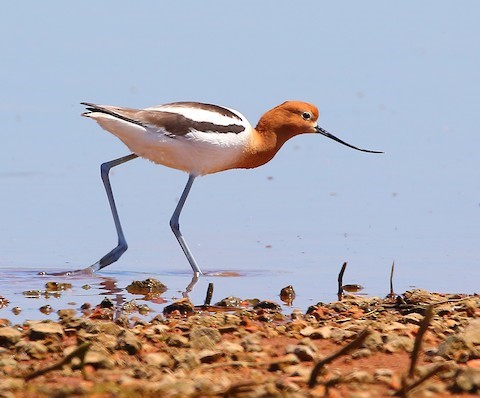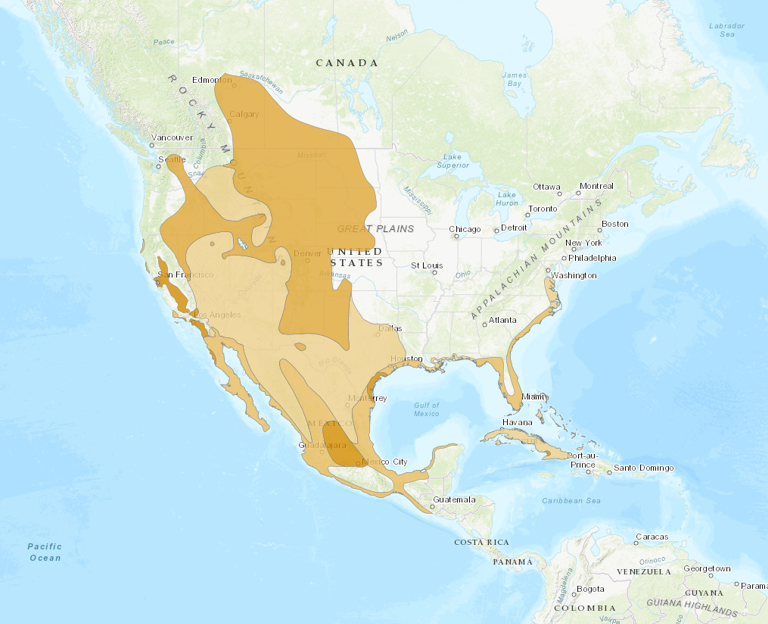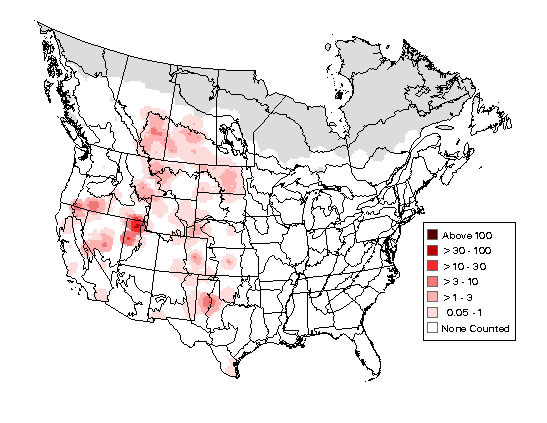Birdfinding.info ⇒ Locally common in its preferred breeding areas in the Great Basin, Great Plains, and Canadian prairies (see Breeding Bird Survey Abundance Map in Notes, below). Also locally common in winter from California to Florida and south into Mexico. From April to October, it occurs unpredictably throughout the eastern U.S. and southeastern Canada, and more predictably at a few sites, including Bombay Hook, Edwin B. Forsythe, and Pea Island National Wildlife Refuges.
American Avocet
Recurvirostra americana
North America: breeding north to central Canada and wintering south to Central America and the West Indies.
Breeding. Lakes and wetland complexes with extensive muddy shallows, mainly in the western interior of North America, north to eastern Washington, central Alberta and Saskatchewan, and southern Manitoba, and south to central Mexico.
Also breeds locally in coastal marshes along the Gulf of Mexico and Eastern Seaboard from Texas and New Jersey to Florida, and sporadically farther north in central Canada, east to marshes around the Great Lakes, south to Cuba.
Nonbreeding. Winters in the southern U.S. from California to South Carolina, south throughout Mexico to Nicaragua and the Greater Antilles: mainly Cuba and the Bahamas; rarely east to Puerto Rico and south to the Cayman Islands, Jamaica, and northwestern Costa Rica; casually to Panama.
Movements. Northbound migration begins in March, with most arriving on the breeding grounds in April and early May.
Post-breeding movements from July to October are highly dispersive, with both adults and juveniles wandering widely within the breeding range and in small numbers throughout the Great Lakes, Mississippi Valley, and elsewhere across the eastern U.S. and southeastern Canada. By late October, most movements are southward to wintering areas.
From spring into fall, wanderers regularly appear at scattered locations north and east of the normal range—especially to southern and central British Columbia, the Athabasca and Great Slave Lake region, southern Quebec, and the Maritimes; and casually to Bermuda and the coasts of Hudson and James Bays.
More exceptional vagrants have been recorded from southern Alaska, Maui, Baffin Island, Greenland, Bonaire, and Ecuador.
Identification
Unique: the only avocet in its range, identifiable by its long, black upturned bill.
A large, long-legged shorebird with boldly contrasting black-and-white wings and back. The legs are gray, often with a strong bluish tint.
Breeding adults have a striking rusty-to-bright-orange blush on the head and neck that progressively blends to white on the lower neck, breast, and mantle. The distinctive coloration typically appears around February and disappears in August or September.
Nonbreeders are pale-gray or whitish instead of rusty on the head and neck, but otherwise like breeding adults.
The sexes differ somewhat in bill shape. Females’ bills are more strongly upcurved. Males’ bills are longer and straighter.
Has fully webbed feet and swims more readily than most shorebirds.

American Avocet, male in breeding plumage. (Merced National Wildlife Refuge, California; April 11, 2020.) © Matt Davis
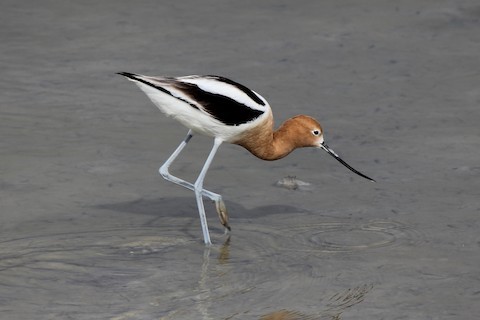
American Avocet, male in breeding plumage. (Powell Lake, Utah; May 7, 2013.) © Kenny Frisch

American Avocet, female in breeding plumage. (Lytle Ranch Preserve, Washington County, Utah; May 13, 2016.) © Tim Avery

American Avocet, male and female in breeding plumage. (Summer Lake, Oregon; June 9, 2018.) © Eric VanderWerf
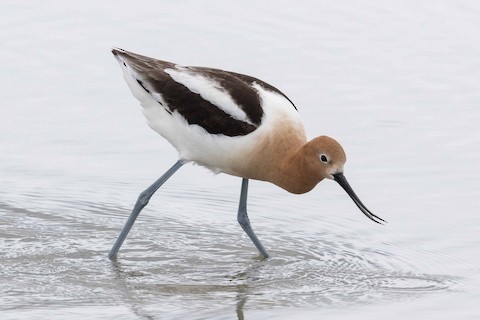
American Avocet, in breeding plumage. (Summer Lake, Oregon; June 9, 2018.) © Eric VanderWerf
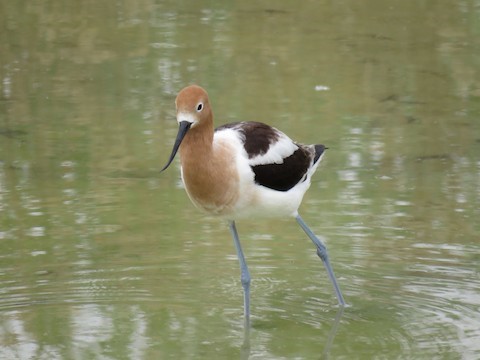
American Avocet, male in breeding plumage. (Henderson Bird Viewing Preserve, Clark County, Nevada; April 5, 2018.) © Joe Yohannon
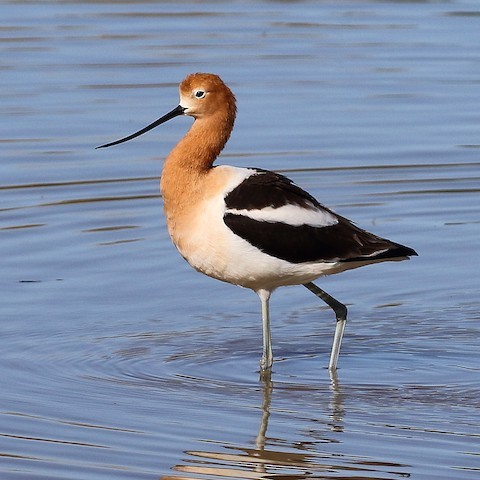
American Avocet, male in breeding plumage. (Riparian Preserve at Gilbert Water Ranch, Gilbert, Arizona; April 2, 2018.) © Dan Vickers
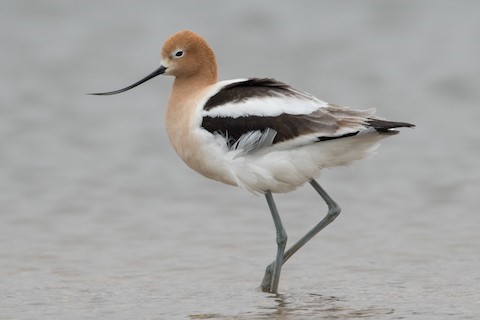
American Avocet, female in breeding plumage. (Lakeshore State Park, Milwaukee, Wisconsin; May 1, 2019.) © Jeremy Meyer
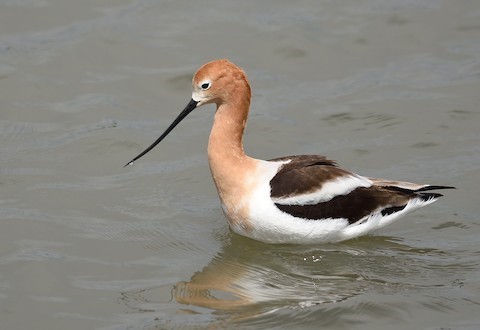
American Avocet, male in breeding plumage. (Arrowhead Marsh, Oakland, California; April 14, 2019.) © Jerry Ting
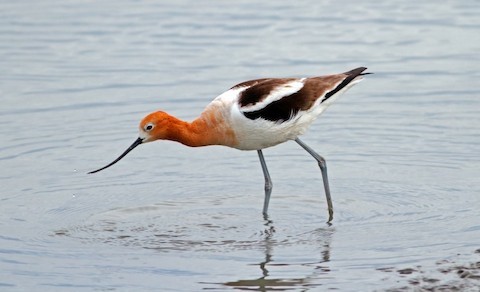
American Avocet, female in vivid orange breeding plumage. (Shoreline Park, Mountain View, California; April 16, 2017.) © Vayun Tiwari

American Avocet, with atypically curved bill, in breeding plumage. (Frank Lake, High River, Alberta; April 30, 2019.) © David M. Bell
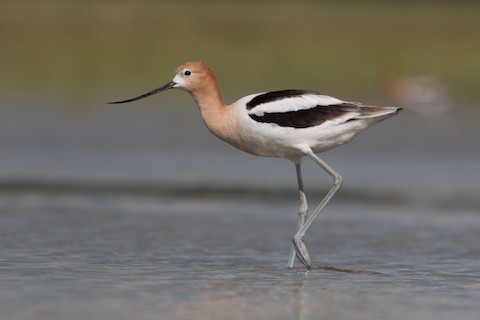
American Avocet, male in breeding plumage, showing webbed foot. (Fort Lonesome, Hillsborough County, Florida; June 24, 2016.) © Joel Strong
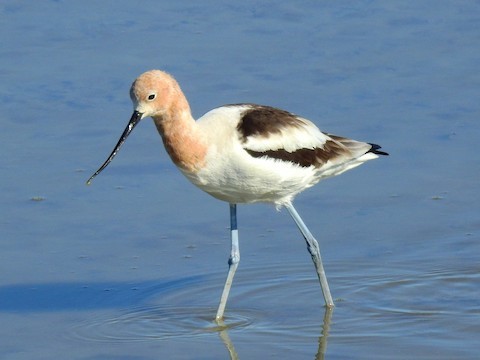
American Avocet, male entering breeding plumage. (Belmont Slough, Redwood City, California; February 21, 2018.) © Joshua Stacy
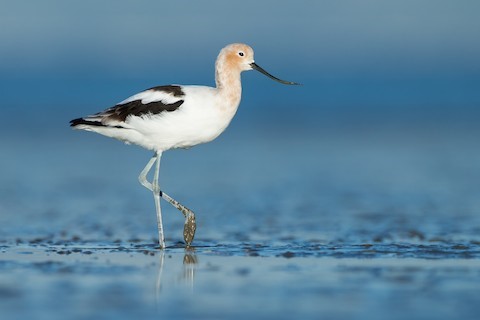
American Avocet, female entering breeding plumage. (Foster City, California; January 31, 2018.) © Dorian Anderson
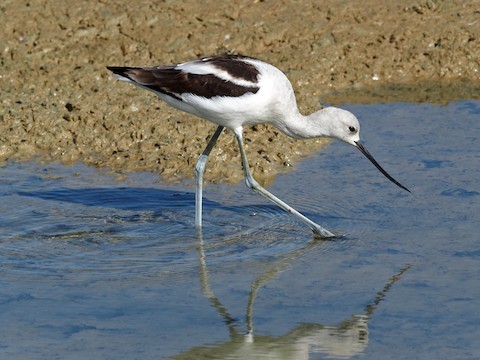
American Avocet, male in nonbreeding plumage. (Ladyville, Belize; November 26, 2019.) © Mary Goodart
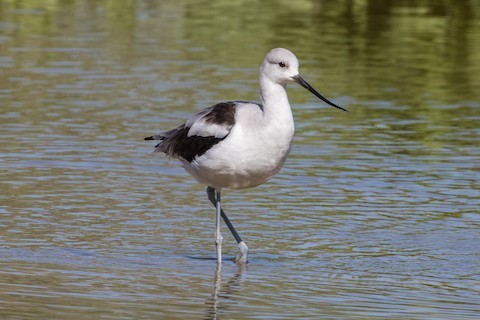
American Avocet, male in nonbreeding plumage. (Riparian Preserve at Gilbert Water Ranch, Gilbert, Arizona; February 22, 2018.) © Michael Warner

American Avocet, male in nonbreeding plumage. (Tyrrell Park, Beaumont, Texas; October 23, 2017.) © Harlan Stewart
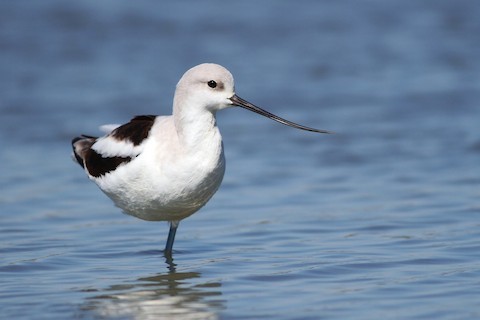
American Avocet, male in nonbreeding plumage. (Indian Pass, Florida; February 20, 2017.) © Alex Lamoreaux
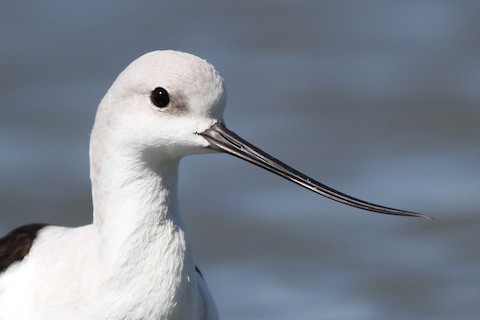
American Avocet, male in nonbreeding plumage, close view of extraordinary upcurved bill. (Indian Pass, Florida; February 20, 2017.) © Alex Lamoreaux

American Avocet, female in nonbreeding plumage. (Santa Ana National Wildlife Refuge, Texas; December 18, 2018.) © Timo Mitzen
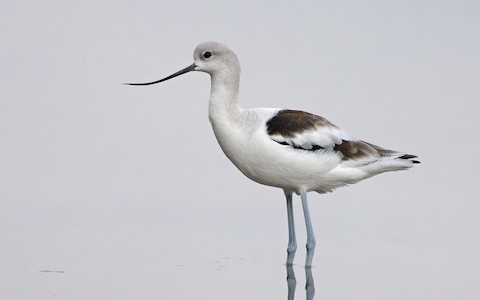
American Avocet, female in nonbreeding plumage. (Meagre Bay Pond, Bodden Town, Grand Cayman; M arch 14, 2020.) © Denny Swaby

American Avocet, female in nonbreeding plumage. (Foster City, California; February 1, 2018.) © Dorian Anderson
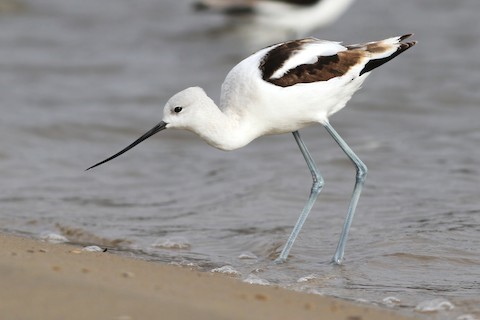
American Avocet, male in nonbreeding plumage. (Coralville Lake, Johnson County, Iowa; October 14, 2020.) © Brandon Caswell
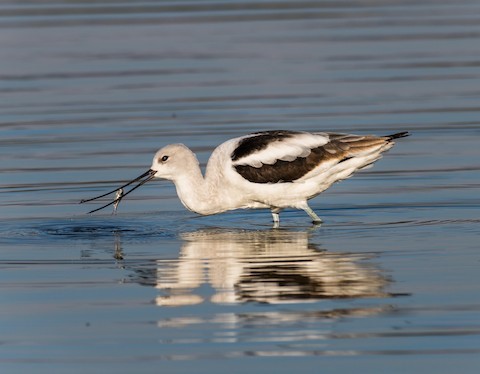
American Avocet, male in nonbreeding plumage, with fish. (Prospect Lake, Colorado Springs, Colorado; October 18, 2019.) © Jim Merritt
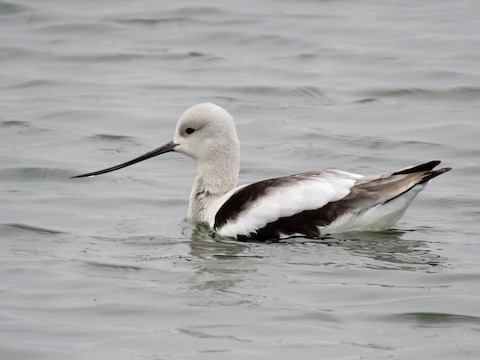
American Avocet, male in nonbreeding plumage, swimming. (Gridley Wastewater Treatment Plant, McLean County, Illinois; October 28, 2019.) © Benjamin Murphy

American Avocet, female in breeding plumage, in flight, showing white underparts with black primaries. (Keystone Heritage Park, El Paso, Texas; May 7, 2019.) © Ad Konings
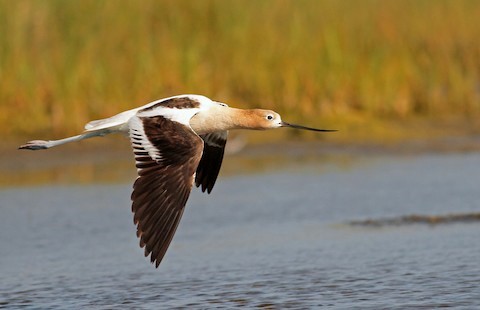
American Avocet, male in breeding plumage, in flight, showing bold black-and-white pattern on back and upperwings. (Scarborough, Maine; July 23, 2012.) © Luke Seitz
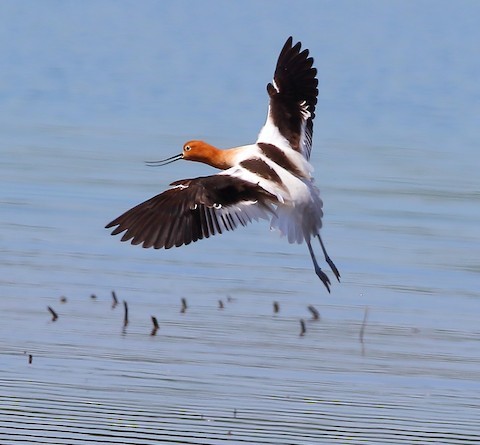
American Avocet, female in breeding plumage, in flight, showing bold black-and-white pattern on back and upperwings. (Marthaler Pond, Muscle Shoals, Alabama; May 7, 2020.) © Bala Chennupati

American Avocet, female in breeding plumage, in flight, showing bold black-and-white pattern on back and upperwings. (Marthaler Pond, Muscle Shoals, Alabama; May 7, 2020.) © Bala Chennupati
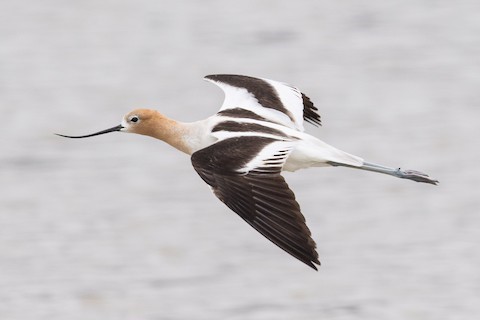
American Avocet, female in breeding plumage, in flight, showing bold black-and-white pattern on back and upperwings. (Summer Lake, Oregon; June 9, 2018.) © Eric VanderWerf
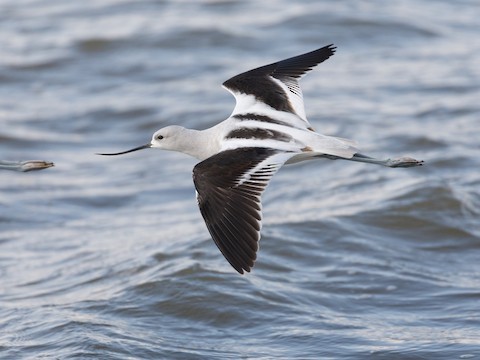
American Avocet, female in nonbreeding plumage, in flight, showing bold black-and-white pattern on back and upperwings. (American Falls, Idaho; October 5, 2018.) © Darren Clark
Voice. Various high-pitched whistles that range from squeaky to piercing:
Notes
Monotypic species.
References
Alderfer, J., and J.L. Dunn. 2014. National Geographic Complete Birds of North America (Second Edition). National Geographic Society, Washington, D.C.
BirdLife International. 2016. Recurvirostra americana. The IUCN Red List of Threatened Species 2016: e.T22693717A93418724. https://dx.doi.org/10.2305/IUCN.UK.2016-3.RLTS.T22693717A93418724.en. (Accessed November 3, 2020.)
eBird. 2020. eBird: An online database of bird distribution and abundance. Cornell Lab of Ornithology, Ithaca, N.Y. http://www.ebird.org. (Accessed November 3, 2020.)
Fagan, J., and O. Komar. 2016. Peterson Field Guide to the Birds of Northern Central America. Houghton Mifflin Harcourt, New York.
Hayman, P., J. Marchant, and T. Prater. 2009. Shorebirds: An Identification Guide. Houghton Mifflin, Boston.
Howell, S.N.G., and S. Webb. 1995. A Guide to the Birds of Mexico and Northern Central America. Oxford University Press.
Kirwan, G.M., A. Levesque, M. Oberle, and C.J. Sharpe. 2019. Birds of the West Indies. Lynx Edicions, Barcelona.
Pyle, R.L., and P. Pyle. 2017. The Birds of the Hawaiian Islands: Occurrence, History, Distribution, and Status. Version 2 (January 1, 2017). http://hbs.bishopmuseum.org/birds/rlp-monograph/. B.P. Bishop Museum, Honolulu, Hawaii.
Raffaele, H., J. Wiley, O. Garrido, A. Keith, and J. Raffaele. 1998. A Guide to the Birds of the West Indies. Princeton University Press, Princeton, N.J.
Ridgely, R.S., and J.A. Gwynne. 1989. A Guide to the Birds of Panama (Second Edition). Princeton University Press.
Salt, W.R., and J.R. Salt. 1976. The Birds of Alberta. Hurtig Publishers, Edmonton, Alberta.
Sibley, D.A. 2000. The Sibley Guide to Birds. Alfred A. Knopf. New York.
Wells, J.V., and A.C. Wells. 2017. Birds of Aruba, Bonaire, and Curaçao. Cornell University Press.
Xeno-Canto. 2020. American Avocet – Recurvirostra americana. https://www.xeno-canto.org/species/Recurvirostra-americana. (Accessed November 3, 2020.)
